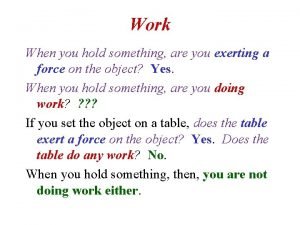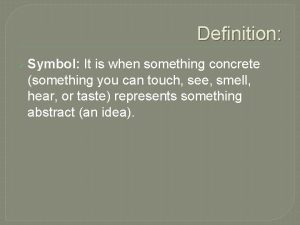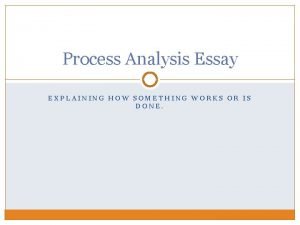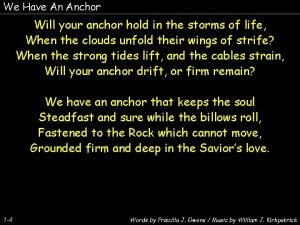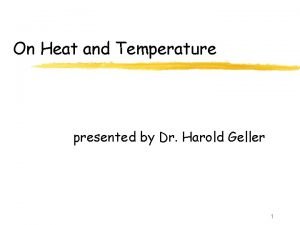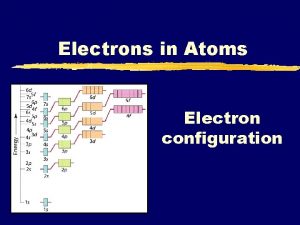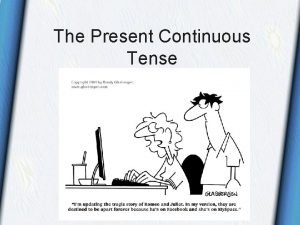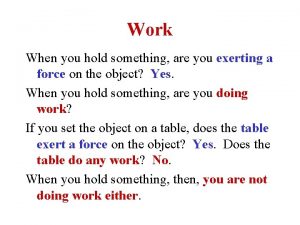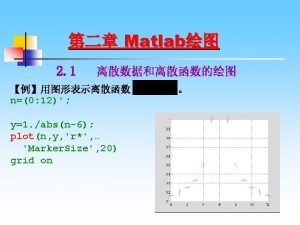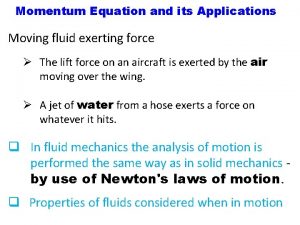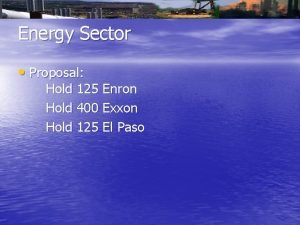Work When you hold something are you exerting































































- Slides: 63

Work When you hold something, are you exerting a force on the object? Yes. When you hold something, are you doing work? ? If you set the object on a table, does the table exert a force on the object? Yes. Does the table do any work? No. When you hold something, then, you are not doing work either.

Work What can you do that the table can’t do? You can lift the object up - which is work! We define the concept of WORK as the exertion of force through a distance. There is one more point about work: in tether ball, does the pole do work while it exerts a force (via the rope) on the ball while the ball moves around the pole? There is both force and distance.

Work We have to feed you for you to be able to do work. Do we have to “feed” the pole (plug it in, put in batteries) before we play tether ball? No, the pole does not do work in the tether ball case. This leads to the following formal definition of work: In doing work, the direction of the force has to be parallel (or anti-parallel) to the distance moved. We write this way: Work ≡ F s where the dot indicates the cosine of the angle between F and s: Work = F s cos(q. Fs).

Work ≡ F s Although F and s are vectors (with magnitude and direction), Work is a scalar (magnitude only). In Math, this is called the dot product of two vectors and results in a scalar. Can we have positive and negative work? If the Force and distance are parallel, the amount of work is positive, but if the two vectors are anti-parallel, then the work is negative.

More general definition of work Work ≡ F s If the force and/or angle varies over the distance, then we must break the distance into small pieces, and use the average force on each piece to find the work on that piece, then add up all the small works to find the total work: W ≡ Fi cos(qi) Dsi If we carry this to the limit using calculus, we get: Work ≡ si sf F cos(q) ds where either or both F and q are functions of the distance, s.

Energy We can now define the concept of energy: Energy is the capacity to do work (in ideal circumstances). We all know that we can do work: exert a force through a distance. But to do that requires food. Thus we convert the energy in food into work. The same thing happens when we burn coal to generate heat which can be converted into electricity which can be converted into lots of useful work.

Conservation of Energy A Natural Law Many such examples as we just saw lead us to propose a natural law. Remember that a natural law is a statement of how nature seems to work - it is not “derived” from anything more basic, it is observed to fit the results of observations (experiments). Energy can neither be created nor destroyed (that is, energy is conserved). However, it can be transformed from one form into another.

Conservation of Energy The equation that comes from this law of conservation of energy is: S Energiesinitially = S Energiesfinally. Our job now is to identify the various forms of energy and then find out how the amount of energy in different forms relates to the various parameters associated with that form. That is, we need to derive formulas for various forms of energy. This is similar to Part 2 where we have Newton’s 2 nd Law and we then derived formulas for the various kinds of forces used in Newton’s 2 nd Law.

Units The units of energy (and work) are: Force thru a distance = work; F = ma Nt*m ≡ Joule = (kg*m/s 2)*m = kg*m 2/s 2. A British unit of energy is the BTU (British Thermal Unit). 1 BTU = 1, 054 Joules (This is the energy necessary to heat one pound of water 1 o. F. ) Another unit of energy is the calorie. 1 calorie = 4. 186 Joules (This is the energy necessary to heat one gram of water 1 o. C. ) However, the calorie we refer to when we eat is really a kilocalorie = 4, 186 Joules. (This is the energy necessary to heat one liter of water 1 o. C. )

Positive and Negative Can we have energies that are negative? First, an analogy: can we have negative money? Yes - it’s called debt. You need to earn money to pay off the debt and reach up to zero. In the same way, some energies can be negative - we need to gain some energy to reach what we define as zero energy.

Forces and Energies Since Energy is the capacity to do work, and work is force thru a distance, then we need to consider every force to see what kind (or form) of energy is associated with it. We first find the kinds of energy, then we try to find how much energy there is in each kind based on the parameters associated with that kind of energy. But from Newton’s Second Law, ΣF = ma, is there an energy associated with the “ma” term as well? Since “ma”, mass times acceleration, relates to the motion, is there energy associated with motion? Can a moving object do work (that is, exert a force through a distance)?

Forms of Energy Kinetic Energy of motion, called Kinetic Energy, should depend on the mass and speed of the object. Your car has energy when it is moving. The wind has energy when it is moving, and we can convert this wind energy into electric energy via windmills.

Potential Energies Energy of position, called Potential Energy, should depend on why that position has energy. Examples: The water stored behind a dam has energy due to it’s height and weight above the base of the dam. We can use this to run a hydroelectric station. The energy in food is due to the molecular binding of the atoms in the food. The same is true for coal, oil and gas. There is also energy stored in the nucleus of atoms nuclear energy.

Some other forms • Heat should depend on the temperature, the type of material, and the amount of material. We burn coal to get heat to turn water into steam and use the steam pressure to get work (or electricity). • Light should depend on the type and the intensity of the light. • Sound should depend on the type and the intensity of the sound.

Kinetic Energy getting a formula If we start with a single net force doing work on an object so that the object picks up speed (and no other energy is involved), we have: Work ≡ si sf F cos(q) ds. Using Newton’s Second Law, with the force simply directed always along the direction of motion: F = ma = m dv/dt we get: Work = si sf m dv/dt ds = vi vf m ds/dt dv and using v = ds/dt we get: Work = vi vf m v dv or finally, Work = ½mvf 2 - ½mvi 2 = KE

Kinetic Energy an alternative derivation If we let an object fall, it gains speed. It also gains what we call kinetic energy. By the Conservation of Energy law, the amount of work going into the object (from gravity) will equal the amount of energy the object has (kinetic): F s cos(q) = mg h (1). But if an object falls a distance h with an acceleration of g, how fast is it going?

Kinetic Energy – alternate derivation KE(m, v) = mgh (The amount of kinetic energy, which depends on the quantities mass and speed in this case equals the amount of work done by gravity, mgh). From our motion equations, v = vo + gt and h = ho + vot + ½gt 2 or in this case (ho=0, vo=0): h = ½gt 2, or t = (2 h/g)1/2 so v = gt = g(2 h/g)1/2, or v = (2 hg)1/2, or h = ½v 2/g; thus mgh = mg½v 2/g = ½mv 2 = KE.

Kinetic Energy - formula KE = ½mv 2 Note that the kinetic energy depends on m (the more mass the more kinetic energy) and on v 2 (if you double the speed, you quadruple the kinetic energy). Also note that the kinetic energy must always be either zero or positive - it can’t be negative. (This is like cash in the money analogy. )

Kinetic Energy - considerations You’ve probably heard the expression: “speed kills”. This comes from the fact that KE depends on the square of the speed. If you increase your speed by a factor of 3, you increase the amount of energy of the object by a factor of 32 = 9. And remember that energy is the capacity to do work - for either good or bad. Uncontrolled energy can exert large forces through significant distances which can be very dangerous!

Kinetic Energy - considerations Note that the difference between (1 m/s)2 and (2 m/s)2 is 3 m 2/s 2, whereas the difference between (99 m/s)2 and (100 m/s)2 is 199 m 2/s 2. What this indicates is that it takes more and more energy to move faster and faster. This explains why there is so little difference between first and tenth in a speed race between trained athletes!

Gravitational Potential Energy If we let the force of gravity act on an object as it moves, gravity is exerting a force through a distance and may add or subtract energy from the object. We can work with this near the earth (where gravity is constant): Work ≡ si sf Fapplied cos(q) ds To lift something up, the applied force is opposite the force of gravity, so with m=mass, g= gravitational field (or acceleration due to gravity), and h= height: Work = hi hf (-Fgravity) dh = hi hf (+mg) dh = mg h = PEgravvity , or PEgravity = mgh.

h and Dh, and g The formula for PEgravity really should be DPEgr = mg. Dh instead of PEgr = mgh. We often use h when we mean h, as in the case of “what is your height? ”. What we mean is, “what is the difference in height between the top of your head and the bottom of your feet? ” We often assume that we are measuring from the floor, ground, or some other standard position. If you use (or see) PEgr = mgh, be sure to interpret it as DPEgr = mg. Dh, and know where the “standard” position of h=0 is. Here g is a positive value. On the earth’s surface, it is +9. 8 Nt/kg.

Gravitational Potential Energy PEgravity = mgh The greater the height, the more potential energy there is - that is, if the object is allowed to fall, the gravity will exert a force through a distance and cause work. We can say that the object has energy due to its height (position). We call this a potential energy.

Gravitational Potential Energy more general form Farther from the earth’s surface, gravity changes with height, and we need a more general formula: Work ≡ si sf Fapplied cos(q) ds. To lift something up, the applied force is opposite the force of gravity, so Work = hi hf (-Fgravity) dh = ri rf (+GMm/r 2) dr = -GMm/rf + GMm/ri = PE , or PEgravity = -Gm 1 m 2/r 12. Here r 12 means the distance between the center of m 1 and the center of m 2.

PE versus DPE We have a similar case here as we did with the near-earth PE: when should we use PE and when should we use DPE ? If we use PE = mgh, we are assuming that there is some standard position where h=0 (usually the ground, the floor, or table top). If we use PE = -GM 1 m 2/r 12 , we are assuming that the “standard r 12” is a position that makes PE = 0; to have this, the “standard r 12” would have to be infinity, since 1/infinity = 0.

PEgravity Considerations In the simpler formula near the earth’s surface, PEgravity = mgh , both m and g are positive numbers, but h is a height measured from some point that you determine. It can be the ground, but doesn’t have to be. Note that h can be either positive or negative since it is possible to be above or below ground level.

PEgravity Considerations In the more general form, PEgravity = -Gm 1 m 2/r 12 , the PE is always negative, with the highest (least negative) value being when PE=0 or r 12 goes to infinity. We are essentially “in debt” to the earth and so are in debtor’s prison. We can escape the earth only if we pay our (energy) debt - for example with rocket fuel energy. Note in particular, that while the force of gravity goes as 1/r 122, the PE of gravity goes only as 1/r 12.

Potential Energy for a spring PEspring = -si s Fspring ds where Fspring = -k(x-xe) We’ll do a lab on this force, called Hooke’s Law, later in the semester. Here xe is the equilibrium (unstretched) position of the spring. Recall that the minus sign in the PE equation comes from the fact that to store energy, we need to provide a force opposite that of the spring. This relation then gives: PEspring = -xe xf –k(x-xe) dx = (½kx 2 – kxxe)|xexf = (½kxf 2 – kxfxe) - (½kxe 2 – kxexe) = (½kxf 2 – kxfxe + ½kxe 2 ) = ½k(x-xe)2 where x has replaced xf, the final position. Note that this PE does depend on the position, x, so PE(x); and that the potential energy is always positive no matter whether the spring is stretched, x>xe , or compressed, x<xe.

Problems Having KE and PEgravity, we can start solving some problems using the Conservation of Energy. Problem: How high will a ball go if it is thrown up with a speed of 25 m/s? We could solve this problem using Newton’s Second Law and the equations for constant acceleration, or we could use Conservation of Energy.

Tossing a ball up Let’s try this problem using Conservation of Energy: We recognize that we have kinetic energy (since we have motion), and we recognize that we have gravitational potential energy (since we have gravity); also vi=25 m/s; hi=0 m (start from the ground); vf=0 (highest point). These are all related by the Conservation of Energy: hf = ? vf = 0 hi = 0 m vi = 25 m/s

Tossing a Ball Up S Energiesinitially = S Energiesfinally. KEi + PEi = KEf + PEf ½mvi 2 + mghi = ½mvf 2 + mghf (note that this is equivalent to saying DKE = DPE, or ½mvf 2 – ½mvi 2 = mg(hf-hi) ½*m*(25 m/s)2 + m*(9. 8 m/s 2)*(0 m) = ½*m*(0 m/s)2 + m*(9. 8 m/s 2)*hf. [Here I use g = 9. 8 m/s 2 instead of 9. 8 Nt/kg since the units work are clearer in this form. ] Here we see that the mass cancels out, and we have one equation in one unknown (hf): hf = ½*(25 m/s)2 / (9. 8 m/s 2) = 31. 89 m.

Observations We should note two things from this example: Conservation of Energy is a scalar equation, and so has no information about directions. This makes it easier to solve, but gives less information in the answer. Conservation of Energy makes no mention of time (only initial and final). This removes t from the problem - making it easier but also giving us less information in the answer. If we solved this by using Newton’s 2 nd Law, we would first have to solve for time and then solve for height.

Escape Speed In the previous example, we threw something up that went about 32 meters high. How fast would we have to throw something to make it escape from the earth altogether (if we continue to neglect air resistance)? We can use Conservation of Energy again, but we need the more general form for potential energy due to gravity. To escape the earth, rf = infinity! We start with ri = Rearth = 6. 4 x 106 m.

Escape Speed S Energiesinitially = S Energiesfinally. KEi + PEi = KEf + PEf ½mvi 2 - Gmearthm/ri = ½mvf 2 - Gmearthm/rf (note that this is equivalent to saying DKE = DPE, or ½mvf 2 – ½mvi 2 = -Gmem/rf - -Gmem/ri) We see that m is in each term, so we cancel it. ½*(vi)2 - [(6. 67 x 10 -11 Nt*m 2/kg 2) *(6. 0 x 1024 kg)/(6. 4 x 106 m)] = ½*(0 m/s)2 - [(6. 67 x 10 -11 Nt*m 2/kg 2) *(6. 0 x 1024 kg)/(infinity)] We again have one equation in one unknown (vi).

Escape Speed We have used vf = 0 m/s since this is the minimum speed we need at the end. We could have more speed when we escape, but we’re looking for the lowest speed for the object to still escape; this means that both the terms on the right side = 0. Solving for vi = vescape = [2*G*Mearth /Rearth ]1/2 = 11, 180 m/s = 25, 000 mph. Recall that to orbit the earth 250 miles above the earth’s surface, we needed a speed of about 17, 000 mph. We would have a hard time solving this if we used Newton’s 2 nd Law since the force of gravity gets less as the object gets higher so we can’t use the equations for constant acceleration. In the Projectile computer homework program, we use a numerical procedure to get an approximate answer.

Friction and Energy Loss Can we use Conservation of Energy if we have friction? What happens with friction? We convert kinetic energy into heat! What “formula” do we use for how much energy is “lost” to friction, that is, how much energy is converted from kinetic to heat?

Friction We start from the basic definition of energy: the capacity to do work, where work ≡ Force thru a distance: Elost = Ffriction * s. We still have Ffriction = m. Fc. Where does this Elost go in the equation for Conservation of Energy: on the initial or final side? Is it a positive or a negative amount of energy?

Friction Since some of the initial kinetic energy will go (transform) into some heat, the Elost should be a positive term if it is on the final side, or a negative term if it is on the initial side. S Energiesinitially = S Energiesfinally. KEi + PEi = KEf + PEf + Elost where Elost = + Ffriction*s = + m. Fcs.

Friction - example Problem: If the coefficient of friction between a block of wood and the concrete floor is 0. 50, how far will a block of wood slide on the floor before coming to rest if it starts with a speed of 10 m/s ? We recognize this as a Conservation of Energy problem with kinetic energy and with friction (Elost).

Friction - an example We are given: vi = 10 m/s; vf = 0 m/s; m =. 5 We are looking for s (the distance of slide). S Energiesinitially = S Energiesfinally. KEi = KEf + Elost where Elost = + Ffriction*s = + m. Fcs. From Fy = 0, we have Fc = mg. Therefore: ½*m*vi 2 = ½*m*vf 2 + m*m*g*s.

Friction - an example ½*m*vi 2 = ½*m*vf 2 + m*m*g*s We notice that there is an m in each term so it cancels out! ½*(10 m/s)2 = 0 + (0. 5)*(9. 8 m/s 2)*s [Here again I use g = 9. 8 m/s 2 instead of 9. 8 Nt/kg since the units work out more clearly in this form. ] This is one equation in one unknown (s): s = ½*(10 m/s)2 / (0. 5)*(9. 8 m/s 2) = 10. 2 m. We could also do an experiment where we measure s and vo and then calculate m from the above Conservation of Energy equation.

Contact Force and Energy Every force we have considered so far has an energy: • gravity (potential energy due to gravity) • friction (energy lost to heat) • spring (potential energy) What about contact force? Since the contact force is not normally able to move an object through a distance, it normally can do no work.

Pulleys and Work Recall the single pulley situation from Part 2: In this case, the pull, P, was only half the weight, W. However, in order to lift the weight up a distance, h, we would have to pull the rope twice that distance! Therefore the work done is W = F*d = (½W)*(2 h) = W*h, P which is the same work with or without the pulley. W

Potential Energy Graphs If we have Potential Energy functions and if we do NOT have energy losses to friction and/or air resistance, we can tell a lot about the motion of a particle if we plot the total potential energy versus distance: Since Etotal = KE + PE PE we can quickly see KE where the KE is big Etotal and where it is small by x looking at the graph of PE(x) versus x.

Potential Energy Graphs Also, since the KE can never be negative, we can quickly see where the particle can never be found (unless the kinetic energy is increased by some outside source). If the PE is greater than the Etotal, this would mean that the KE would have to be negative, but that Etotal is not possible. PE KE particle not permitted x

Potential Energy Graphs Also, from the definition of work and PE: PE ≡ -si s F ds we have -d. PE(s)/ds = Fs which says that the direction of the force is opposite that of the slope of the PE curve. That is, if the PE slope is negative, the Force KE is directed positive Etotal F (which will make the KE bigger if it moves in that direction), and the steeper the slope, the bigger the Force. F x

Potential Energy Graphs an Example: We saw a little bit ago that the potential energy for a spring is PE(x) = ½(x-xe)2. This plots as a parabola with the minimum at x = xe. When x > xe, the force is towards xe, and when x < xe, the force is still towards xe. If the spring is stretched and released, it will oscillate and go fastest when x = xe and go slowest as it approaches the near and far parts of its oscillation. PE(x) KE F xe x particle never here The green dotted line on the above graph marks the constant total energy.

Power We now know what Force and Energy are. Forces tend to change an object’s motion: ΣF=m(dv/dt). Energy is the capacity to exert a force through a distance. Forces in the direction of the velocity will increase or decrease the speed and hence change the kinetic energy; forces perpendicular to the velocity will change the direction but will not change the speed so there is no change in the kinetic energy. But what is Power?

Power We now know what Force and Energy are, but what is Power? The definition of Power is that it is the rate of change of Energy: Power ≡ Energy / t. The units of power are: Joule/sec ≡ Watt. Another common unit is the horsepower, hp. The conversion factor is: 1 hp = 746 Watts.

Power - example What is your power output when you climb stairs? In this case, you are changing your potential energy (mgh) in time, so P = Dmgh / Dt. If your mass = 70 kg, gravity is 9. 8 Nt/kg, and you climb steps of height 10 meters in a time of 20 seconds: P = 70 kg * 9. 8 Nt/kg * 10 m / 20 sec = 343 W [Units: Nt*m/s = Joule/sec = Watt] or 343 W * (1 hp / 746 W) =. 46 hp.

Power - example What is your average power output per day? If you eat 2, 000 Calories per day, (and assuming you do not gain or lose weight), that energy must be converted into energy you use throughout the day. P = 2, 000 Calories / day = [(2, 000 Cal)*(4, 186 joule/Cal)] / [(24 hours)*(60 min/hr)*(60 sec/min)] = 97 Watts. In climbing the stairs in the previous slide, your energy = P*t = 343 Watts * 20 sec = 6, 860 J = 1. 64 Calories [but your body is not 100% efficient, so you actually burned a little more].

Power – another example How powerful must a car engine be (on average) if it is to accelerate a 2, 000 kg car from zero to 65 mph in 9 seconds? For now, we will neglect friction and air resistance and any other power requirements like air conditioning or car lights. This is a power question. The change in energy is in the form of kinetic energy. We should convert 65 mph into metric form: vf = 65 mph * (1 m/s / 2. 24 mph) = 29 m/s. vi = 0 (starts at rest); Dt = 9 sec.

Power – another example Power ≡ Energy / t = [ {½*m*vf 2} – {½*m*vi 2}] / Dt = [(½*(2, 000 kg)*(29 m/s)2 - 0 ] / 9 sec = 93, 444 Watts * (1 hp / 746 Watts) = 125 hp. Note that this is the average power. We could also calculate power using work/time = Force times distance per time, where a = ∆v/∆t = (29 m/s)/(9 s) = 3. 22 m/s 2; s = so + vot + ½at 2 = 0 + (½)(3. 22 m/s 2)(9 s)2 = 130. 5 m; F = ma = (2, 000 kg)(3. 22 m/s 2) = 6, 444 Nt; W = F*s = (6, 444 Nt)(130. 5 m) = 841, 000 J; P = W/t = (841, 000 J)/(9 s) = 93, 444 W = 125 hp.

Force and Power We know how force is related to energy, and how energy is related to power. Can we relate force to power? Work ≡ F ● s , Power ≡ DWork /Dtime = F ● Ds /Dt (but Ds/Dt = v), so Power = F v. Recall that the dot product of two vectors is the magnitude of the two vectors times the cosine of the angle between them. Power, like work, is a scalar. Note that if Force is constant, Power must go up as speed (v) goes up! If Power is constant, Force must go down as v goes up.

Force and Power = F v At very low speeds, even a small power will give a rather large force! On cars with manual transmissions, you normally don’t rev up the engine (high power), and then pop the clutch! This causes tremendous forces that can break the car! This break can be in the engine, transmission, drive train, or the grip of the tires (friction) on the road (spin your tires). Most people will gradually push down on the accelerator when picking up speed since they want a constant acceleration which means they need a constant force and so they need more power as the speed increases.

Force and Power = F v We can use this equation to find an expression for the F of the engine on the car based on its power: Fengine = P/v. If we combine this with the force of air resistance: FAR = bv 2, we can use Newton’s 2 nd Law: SF = ma to get: Fengine – FAR = ma. As v goes up, Fengine goes down and FAR goes up until we get Fengine = FAR, which means a = 0, which means we are at maximum speed: P/v = bv 2 , or vmax = (P/b)1/3 A spreadsheet has been prepared showing Power and Force versus speed including air resistance using the numerical method, and it is available for download on the web page.

What do you pay for: Force, Energy, or Power? What do you pay MLG&W for: force, energy or power? What do you pay the gas station for: force, energy or power? Force, energy, and power are all related, so the question is what do you directly pay for: $/Nt, $/J, or $/W ?

What do you pay for: Force, Energy, or Power? What do you pay MLG&W for: force, energy or power? What do you pay the gas station for: force, energy or power? In both cases you pay for ENERGY!

Cost of Energy What is the cost of energy? We saw before that we could do work at the rate of a couple hundred Watts, but that was hard work! If we worked for 40 hours a week, how much useful work would we perform? Work = Energy = Power * time. The MKS unit of energy is the Joule, but this is a very small unit. Another common unit of energy is the kilowatt*hour where 1 k. W*hr = (1, 000 J/s)*(1 hr * 3600 s/hr) = 3, 600, 000 J.

Cost of Energy How much useful work would we perform? In terms of kilowatt-hours, if you worked at the rate of 200 Watts for 40 hours, you would do 8 k. W-hrs of work. How much does the energy company charge for a k. W-hr of energy?

Cost of Energy In Memphis, MLG&W charges about 10 cents per k. W -hr. Thus, if you were to work for the power company providing energy, you would earn about 8 k. W-hr/week * $. 10/k. W-hr = $. 80/week (80 cents per week)! As we see, energy is quite cheap! The reason our utility bills are so high is that we use so much energy - especially when we heat (or cool) things (like air and water)! The energy in a gallon of gasoline is 114, 000 BTU = 1. 20 x 108 J = 33. 4 k. W-hrs. Note: your car engine is not 100% efficient in converting this energy into useful energy – about 75% is lost into the heat of the exhaust. Power plants that use heat to run electric generators are only about 30 -35% efficient so 65 -70% is lost into waste heat. There is also a small amount of energy lost in the electric transmission lines.

Cost of Solar Energy Solar energy directly from the sun at the earth’s distance from the sun is about 1, 600 Watts per square meter. About 25% is reflected from the atmosphere before reaching the surface. At noon on a sunny day, we might get 1, 200 Watts/m 2. On average we get about 250 -300 Watts/m 2. Our solar collectors are only about 20% efficient in converting this sunlight into electricity. To get the energy of 1 gallon of gasoline, we would need to collect the energy from 1 m 2 of collector for: 33, 400 Watt-hrs / (300 Watts * 0. 20) = 556 hours = 23 days. For solar energy to be financially viable, you need to consider the cost of the collectors, the cost of the storage (usually batteries), and the cost of financing; and realize that solar collectors do wear out in about 25 -30 years (about the same as the shingles on your roof).

More Examples The computer homework program, Energy and Power, Volume 2, #1, deals with problems involving both energy and power. We have two labs that also deal with energy: Atwoods Machine and Hooke’s Law. There are more examples in the Part 3 Set Extra powerpoint slides.
 Kei+pei=kef+pef this equation represents
Kei+pei=kef+pef this equation represents Antigentest åre
Antigentest åre Smart is something you become not something you are
Smart is something you become not something you are Invisible hand principle
Invisible hand principle A concrete object that represents something abstract
A concrete object that represents something abstract It tells how something works or why something happens
It tells how something works or why something happens The room is an oven figurative language
The room is an oven figurative language Theme vs topic
Theme vs topic Symbol/symbolism definition
Symbol/symbolism definition Something old something new poem
Something old something new poem Something that describes something
Something that describes something Something you aim for that takes planning and work
Something you aim for that takes planning and work Death could not hold you the veil tore before you meaning
Death could not hold you the veil tore before you meaning Theory of metal cutting mcq
Theory of metal cutting mcq Taking something that doesn't belong to you
Taking something that doesn't belong to you If you deserve something you are
If you deserve something you are ?ℴ??ℯ ℳ? ℰ?ℯ?? ℳℴ?ℯ??
?ℴ??ℯ ℳ? ℰ?ℯ?? ℳℴ?ℯ?? You hold a picture motionless against a wall
You hold a picture motionless against a wall Work present simple tense
Work present simple tense Something you never leave home without top 7
Something you never leave home without top 7 How do you analyse something
How do you analyse something Something bother you
Something bother you How do you analyse something
How do you analyse something Name something that little kids hate
Name something that little kids hate So be your name buxbaum
So be your name buxbaum How do you know if something has energy
How do you know if something has energy How do you know something is alive
How do you know something is alive Have you ever done something dangerous
Have you ever done something dangerous Is trousse masculine or feminine
Is trousse masculine or feminine How do you know if something is living
How do you know if something is living Name something you put on a burger
Name something you put on a burger Have you ever thought about inventing something
Have you ever thought about inventing something The great gatsby chapter 7
The great gatsby chapter 7 Is being signed
Is being signed I am sure you have heard something like
I am sure you have heard something like If you were asked to design a new unit to count something
If you were asked to design a new unit to count something Name something you associate with superman
Name something you associate with superman 1827-1770
1827-1770 What have you learned lately
What have you learned lately Fastened to the rock which cannot move
Fastened to the rock which cannot move Better off together lyrics
Better off together lyrics The second coming structure
The second coming structure Sdb student required info mdc hold
Sdb student required info mdc hold Convertitore analogico digitale funzionamento
Convertitore analogico digitale funzionamento Instrument hold line
Instrument hold line Romeo wherefore art thou
Romeo wherefore art thou Out your
Out your Hold thy desperate hand art thou a man
Hold thy desperate hand art thou a man The capacity of air to hold water vapor
The capacity of air to hold water vapor A tool used to hold objects firmly in place is called
A tool used to hold objects firmly in place is called Hold your horses idiom meaning and sentence
Hold your horses idiom meaning and sentence Holding speeds
Holding speeds Hold to god's unchanging hand history
Hold to god's unchanging hand history Hold fast to tradition
Hold fast to tradition Setup time and hold time in digital electronics
Setup time and hold time in digital electronics Electronic configuration order
Electronic configuration order Multiple opportunity method aba
Multiple opportunity method aba Chapter 15 section 2: the second new deal takes hold
Chapter 15 section 2: the second new deal takes hold What is trecs local gov clearinghouse
What is trecs local gov clearinghouse What is a displaced threshold on a runway
What is a displaced threshold on a runway A hold fényváltozásai
A hold fényváltozásai Gssec
Gssec Full nelson hold
Full nelson hold Hold present continuous tense
Hold present continuous tense
